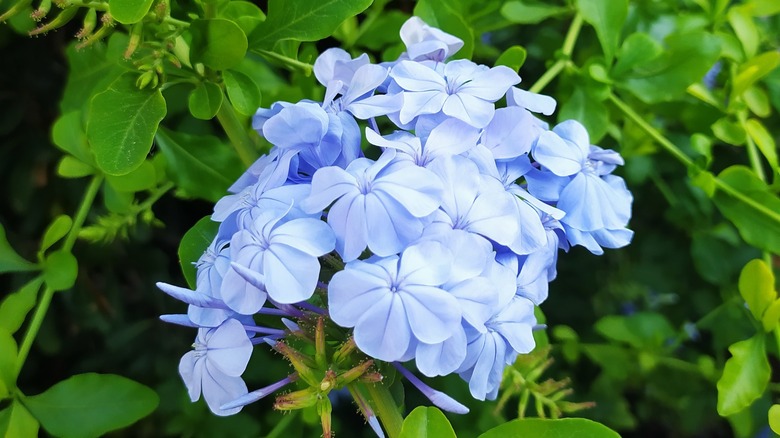The Best Way To Care For Beautiful Plumbago In The Winter
We may receive a commission on purchases made from links.
Want your plumbago (Plumbago auriculata) to look picture-perfect in spring? There are some steps you'll need to know before planting plumbago, including how to winterize it like a pro. Known for its delicate blue, white or pink blooms and weak stems, plumbago — also called Cape leadwort — brightens your garden. This rare blooming shrub is also a bee and butterfly magnet, and it's often used for borders, hedges, or planted in containers. It's particularly beautiful when cascading over the side of a planter or down a retaining wall. Native to South Africa, it thrives in USDA hardiness zones 8 to 11. If your climate is colder, you'll need to give it a little extra TLC to help it survive the winter months.
Winter care depends on your zone. In zones 8 or warmer, simply place a protective layer of mulch around your plant and prune it back to promote spring growth. In colder zones, take action before the first frost by digging up and potting the plant. If you live in regions north of zone 8 where winters are colder, growing plumbago in a container is ideal, allowing you to move it easily indoors or to a protected space like a garage or basement. With a bit of special care, it'll be ready to thrive again when spring arrives.
How to overwinter plumbago plants
Plumbago can survive the winter as either a dormant plant or a blooming houseplant. Either way, be sure to protect it before the first frost. When bringing it inside as a houseplant, look for a place that's warm with plenty of sunlight. If you've chosen a good location, your plumbago can keep blooming year-round, but water sparingly over the winter. Late in the season, you will want to prune it. If you are new to pruning houseplants, take some time to learn beginner gardening tips to prune your houseplants like the pros. Plumbago benefits from hard pruning, which means cutting back most of the stems. One note of caution: be sure to wear protective gear, like Cooljob gardening gloves, when handling plumbago, as it can cause contact dermatitis, an uncomfortable, itchy rash. If you do accidentally make contact with your skin, wash right away with warm, soapy water. Also, make sure to keep plumbago plants out of reach of any pets. After taking these steps, you can enjoy plumbago blooms long into the winter.
You can also overwinter your plumbago as a dormant plant. For this method, you'll need to find a dry, dark spot that's cool but still protected from freezing. Ideal locations include unheated basements, garages, or some greenhouses. Then, simply give it a hard pruning after it goes dormant.

